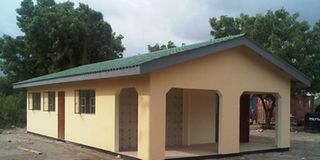House construction costs up 30pc despite fall in cement prices

A house under construction. PHOTO|FILE
What you need to know:
CAHF values innovation, evidence-based decision-making, collaborative networks, and local expertise, and focuses on promoting the opportunities to be found in under-served housing markets across Africa, with a specific focus on the Southern African Development Community (Sadc) region.
Dar es Salaam. The cost of developing a house has gone up by about 30 per cent in four years despite a drop in cement prices, a new study shows.
The report by the Center for Affordable Housing Finance (CAHF) shows that building a two-bedroom housing unit with 65 square meters would cost $16,130 in 2011 but the same has gone up to $20,992 in 2015.
Established in 2014, CAHF’s vision is to enable affordable housing finance system in countries throughout Africa, where governments, business, and advocates work together to provide a wide range of housing options accessible to all.
CAHF values innovation, evidence-based decision-making, collaborative networks, and local expertise, and focuses on promoting the opportunities to be found in under-served housing markets across Africa, with a specific focus on the Southern African Development Community (Sadc) region.
Experts say the trend is mainly influenced by high costs of several other construction materials which are subject to taxation.
The report shows that the cost of a 50kg bag of cement has fallen from $9 in 2011 to $7 in 2015, thanks an increase in the number of local producers.
Until 2011, Tanzania was home to three cement manufacturers namely Tanzania Portland Cement (Twiga), Tanga Cement (Simba) and Mbeya Cement (Tembo).
To date, there are at least eight factories including Athi Rivers Mining’s (ARM) (Rhino cement), Dangote Cement, Camel Cement, Lake Cement, and Lee Building Materials.
However, the cost of cement in Tanzania is said to be higher than the average price of $5.6 which applies within the Sadc region.
The Watumishi Housing Company (WHC) chief finance and administration officer Mr Paskali Masawe told the BusinessWeek that most of the construction materials are imported.
“I understand that cement is currently cheap because it is produced locally but most of the other construction materials are imported from abroad,” he said.
Mr Masawe said the cost may have been escalated by the Value-Added Tax (VAT) on the construction materials.
Tanzania charges VAT on both the building materials and the housing.
“The relatively healthy economic growth and good political management of the country provide an adequate platform for this. There is a great need for affordable housing finance smaller and better priced mortgages for the average Tanzanian,” states the report.
“Beyond mortgage finance, there are real opportunities for growth in the housing microfinance sector, which is also receiving policy attention and funding support.
High levels of self-build coupled with a vibrant microfinance industry with good links to the formal banking sector, and experimentation with housing, mean that housing microfinance has enormous potential to contribute towards housing the majority of the population,” it adds.
One of the big challenges in the housing sector is presence of the VAT which stakeholders say it has been escalating the cost of houses.
The government said it was working on the possibility to waive VAT on the low-cost housing to make them more affordable to ordinary Tanzanians but the plan has not yet matured.
The report also indicates that Tanzania’s mortgage market is among the smallest in the East African region.
The ratio of outstanding mortgage debt to Gross Domestic Product (GDP) was 0.48 per cent as at June 30, 2015.
According to the 2014 Global Findex Survey, only 4.5 per cent of the adults aged 15 and above report having an outstanding loan to purchase a home.
According to the Bank of Tanzania (BoT 2014), the mortgage market recorded an annual growth rate in mortgage loan balances of 59 per cent and growth in number of 29 per cent.
Total mortgage debt stood at Sh334 billion on June 30, 2015, the study shows while average loan size was Sh75 million.
Tanzania is also reported to have high interest rates of between 18 and 22 per cent charged on long-term financing.


